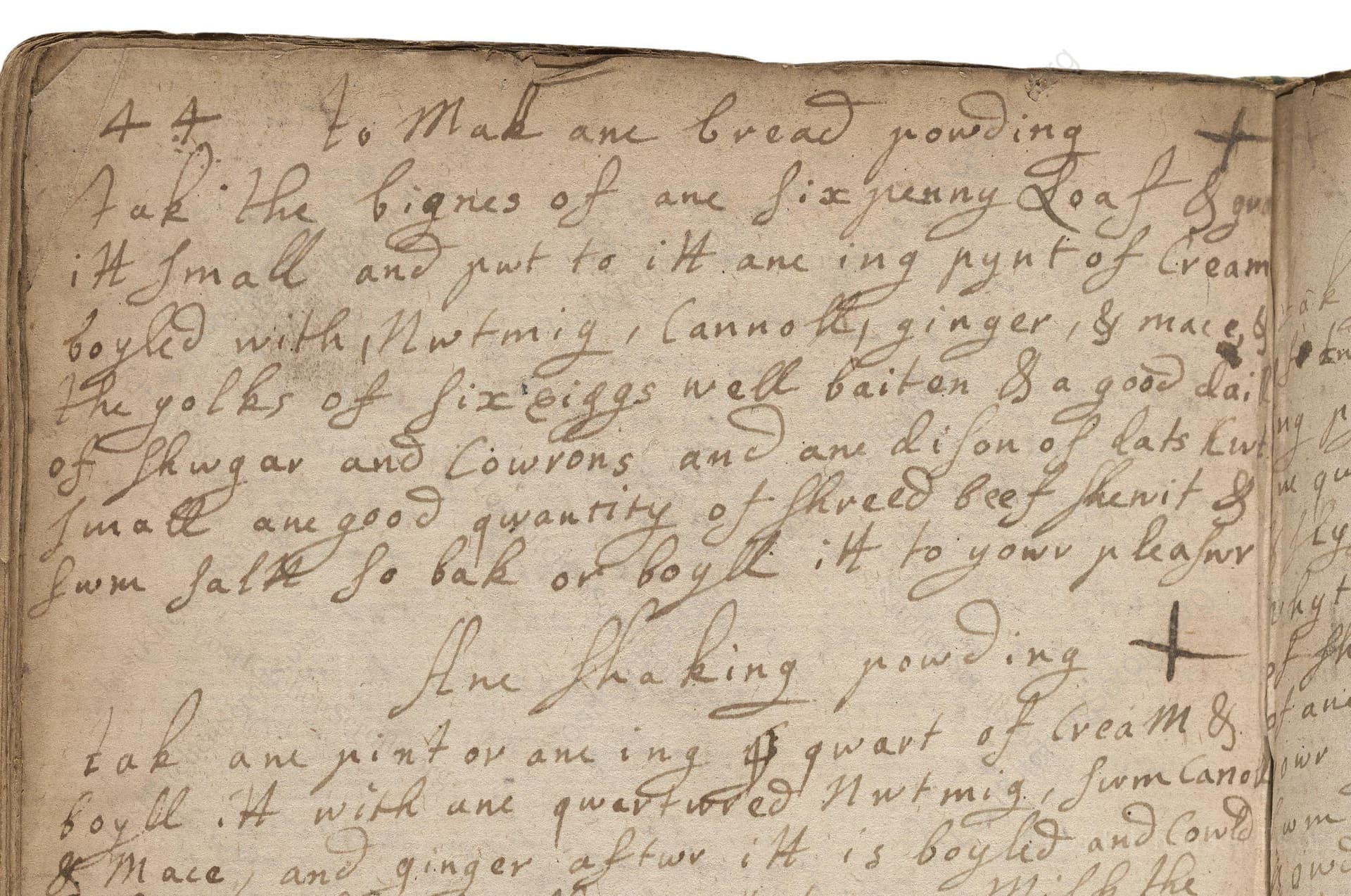To Mak An Bread Powding
From the treasured pages of Medicinal, household and cookery recipes
Unknown Author

To Mak An Bread Powding
"Tak the bignes of ane six penny Loaf & cutt it small and put to it ane ing pynt of Cream boyled with, Nwtmig, Cannon, ginger, & mace, & the yolks of six Eggs well baiten & a good dai- rie of shugar and Cowrons & ane dison of dats Live small ane good gwantity of shreed beef suet & sum salt So bak or boyll itt to your pleasr"
Note on the Original Text
This recipe is written in the informal, narrative-driven style typical of the seventeenth century, relying heavily on the cook's own judgment ('to your pleasr'). Quantities like 'the bignes of ane six penny Loaf' reference everyday market sizes. Spelling is non-standard ('boyled', 'Nwtmig', 'dairie'), reflecting the lack of strictification in English orthography before Johnson’s Dictionary. Instructions are brief, assuming the reader had sufficient culinary know-how to fill in the gaps.

Title
Medicinal, household and cookery recipes (1675)
You can also click the book image above to peruse the original tome
Writer
Unknown
Era
1675
Publisher
Unknown
Background
A delightful glimpse into 17th-century kitchens, this manuscript serves up a smorgasbord of recipes and culinary wisdom, capturing the flavors and flair of early modern cooking.
Kindly made available by
Folger Shakespeare Library
This bread pudding recipe hails from between 1650 and 1700, a time when even the humblest leftovers were transformed with luxurious embellishments in British kitchens. Dishes like this made use of stale bread—a staple in every home—while adding richness with cream, eggs, and dried fruits. Suet puddings were particularly popular, especially among households that could afford such ingredients. The originality of this recipe also lies in its blend of expensive imported spices and dried fruits, reflecting both the aspiration and increasing accessibility of exotic flavors in post-Restoration England.

At the time, preparation would have involved a large wooden trencher or bowl for mixing, a stout knife for cutting the bread, and maybe a heavy ceramic or metal pudding basin for baking or boiling. The eggs would be whisked with a birch twig or a fork. The pudding might be baked in a brick oven, or boiled by tying up the mixture in a thick linen cloth and simmering in a cauldron over an open fire. Measurements were imprecise, typically relying on eye and experience.
Prep Time
15 mins
Cook Time
45 mins
Servings
8
We've done our best to adapt this historical recipe for modern kitchens, but some details may still need refinement. We warmly welcome feedback from fellow cooks and culinary historians — your insights support the entire community!
Ingredients
- 1 medium white loaf (approx. 14oz), crusts removed if desired
- 1 pint double cream
- 1/4 tsp grated nutmeg
- 1/4 tsp ground cinnamon
- 1/8 tsp ground ginger
- 1/8 tsp ground mace
- 6 large egg yolks
- 3/4 cup caster sugar
- 2 1/2 oz currants
- 12 dates, finely chopped
- 3oz shredded beef suet (or 3oz cold grated unsalted butter as substitute)
- A good pinch of salt
Instructions
- Begin by slicing a medium white loaf (about 14oz) into small pieces.
- In a saucepan, gently heat 1 pint of double cream with freshly grated nutmeg (about 1/4 teaspoon), a generous pinch each of ground cinnamon, ground ginger, and ground mace.
- Allow the cream to just come to a simmer, then take it off the heat to cool slightly.
- In a bowl, whisk together the yolks of 6 large eggs with about 3/4 cup caster sugar.
- Pour the slightly cooled spiced cream over the eggs and whisk to combine.
- Add the bread pieces to the liqid, along with 2 1/2 oz currants, 12 chopped dates, 3oz shredded beef suet (or substitute with grated cold butter), and a good pinch of salt.
- Stir well to merge all ingredients.
- Pour the mixture into a greased ovenproof dish.
- Bake in a preheated oven at 340°F for about 40–50 minutes, or until set and golden.
- Alternatively, you could steam the pudding gently for 1–1.5 hours.
- Serve warm.
Estimated Calories
450 per serving
Cooking Estimates
You will need about 15 minutes to prepare the ingredients and put the pudding together. It takes roughly 45 minutes to bake until golden. Each serving contains about 450 calories, and the recipe makes 8 servings.
As noted above, we have made our best effort to translate and adapt this historical recipe for modern kitchens, taking into account ingredients nowadays, cooking techniques, measurements, and so on. However, historical recipes often contain assumptions that require interpretation.
We'd love for anyone to help improve these adaptations. Community contributions are highly welcome. If you have suggestions, corrections, or cooking tips based on your experience with this recipe, please share them below.
Join the Discussion
Rate This Recipe

Den Bockfisch In Einer Fleisch Suppen Zu Kochen
This recipe hails from a German manuscript cookbook compiled in 1696, a time whe...

Die Grieß Nudlen Zumachen
This recipe comes from a rather mysterious manuscript cookbook, penned anonymous...

Ein Boudain
This recipe comes from an anonymous German-language manuscript cookbook from 169...

Ein Gesaltzen Citroni
This recipe, dating from 1696, comes from an extensive anonymous German cookbook...
Browse our complete collection of time-honored recipes



